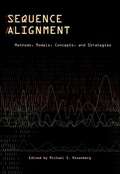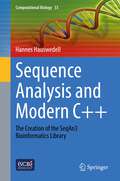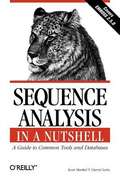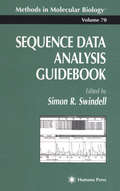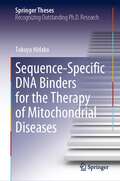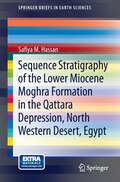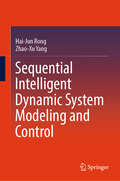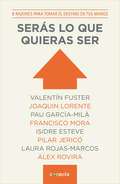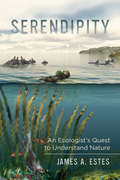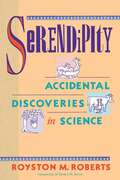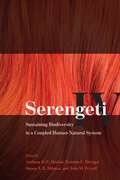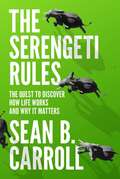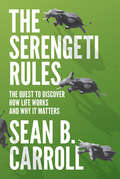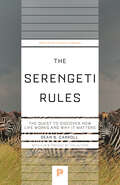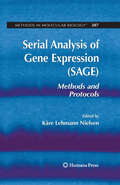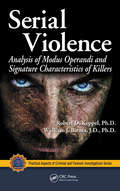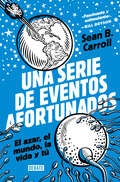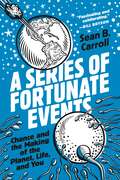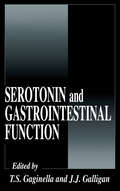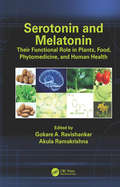- Table View
- List View
Sepup Science Grade 6 (Indiana Edition)
by Sepup Science EducationThis different kind of science program uses several kinds of activities to teach life, earth and physical science concepts. This student book is a compilation of SEPUP publications, customized to align to the Indiana Core Content Expectations, for Science Grade 6.
Sequence Alignment: Methods, Models, Concepts, and Strategies
by Michael S. RosenbergThe sequencing of the human genome involved thousands of scientists but used relatively few tools. Today, obtaining sequences is simpler, but aligning the sequences--making sure that sequences from one source are properly compared to those from other sources--remains a complicated but underappreciated aspect of comparative molecular biology.
Sequence Analysis and Modern C++: The Creation of the SeqAn3 Bioinformatics Library (Computational Biology #33)
by Hannes HauswedellThis is a book about software engineering, bioinformatics, the C++ programming language and the SeqAn library. In the broadest sense, it will help the reader create better, faster and more reliable software by deepening their understanding of available tools, language features, techniques and design patterns.Every developer who previously worked with C++ will enjoy the in-depth chapter on important changes in the language from C++11 up to and including C++20. In contrast to many resources on Modern C++ that present new features only in small isolated examples, this book represents a more holistic approach: readers will understand the relevance of new features and how they interact in the context of a large software project and not just within a "toy example". Previous experience in creating software with C++ is highly recommended to fully appreciate these aspects.SeqAn3 is a new, re-designed software library. The conception and implementation process is detailed in this book, including a critical reflection on the previous versions of the library. This is particularly helpful to readers who are about to create a large software project themselves, or who are planning a major overhaul of an existing library or framework. While the focus of the book is clearly on software development and design, it also touches on various organisational and administrative aspects like licensing, dependency management and quality control.
Sequence Analysis in a Nutshell
by Darryl Leon Scott MarkelSequence Analysis in a Nutshell: A Guide to Common Tools and Databasespulls together all of the vital information about the most commonly used databases, analytical tools, and tables used in sequence analysis. The book contains details and examples of the common database formats (GenBank, EMBL, SWISS-PROT) and the GenBank/EMBL/DDBJ Feature Table Definitions. It also provides the command line syntax for popular analysis applications such as Readseq and MEME/MAST, BLAST, ClustalW, and the EMBOSS suite, as wel
Sequence Data Analysis Guidebook
by Simon R. SwindellLeading researchers concisely summarize their hands-on experiences and methods for successfully using the most popular sequence analysis software packages available. These experts demonstrate how to examine the data produced by modern automated sequencers, how to assess its quality, how to remove extraneous data, how to align multiple overlapping sequence fragments for either assembly into sequence contigs or comparison with similar sequences from different sources. Procedures for comparing newly derived sequences with the massive amounts of information in the sequence databases are fully covered, as are techniques for performing restriction analysis, searching for open reading frames, calculating the translation products of open reading frames, and making detailed analyses of the expressed "proteins."
Sequence-Specific DNA Binders for the Therapy of Mitochondrial Diseases (Springer Theses)
by Takuya HidakaThis book describes the author’s work on the development of sequence-specific DNA binders for the therapy of mitochondrial diseases. In the first chapter, the author provides a detailed background of pyrrole–imidazole polyamides (PIPs) and mitochondrial disease research followed by chapters presenting the author's own research and discoveries. Firstly, the developed compounds called MITO-PIPs, which recognize specific sequences in mitochondrial DNA, are presented. The following chapter demonstrates how, by introducing a DNA alkylating reagent into a MITO-PIP that recognizes the adjacent sequence to a target mutation, the copy number of mutated mitochondrial DNA was successfully reduced in live cells. Furthermore, because nuclear DNA is another important target for treating mitochondrial diseases, the author demonstrated that tri-arginine vectors can enhance nuclear uptake of PIPs and improve their biological activity in cells.This work will attract readers’ interest because it paves the way for a transgene-free chemical gene therapy for mitochondrial diseases. The book includes a detailed description of experimental procedures, especially compound synthesis. This description helps readers to have a clear image of the author’s studies and to perform similar and extended studies themselves.
Sequence Stratigraphy of the Lower Miocene Moghra Formation in the Qattara Depression, North Western Desert, Egypt
by Safiya M. HassanThe Qattara Depression is part of the Northwestern Desert in Egypt and is home to the second lowest point in Africa at -133 meters below sea level. Therefore, before any projects can be carried out in this area, we must first understand the geology of the land. The present study deals with the high-resolution sequence stratigraphic analysis of the Lower Miocene Moghra Formation outcrops in the Qattara Depression Region. The literature on the sedimentology and sequence stratigraphy of the Moghra Formation has been sparse to date, despite some excellent work over the years by academic and petroleum workers. Moreover, the area studied is within what was once a front-line of World War II, where mine fields and war relics are scattered and cover wide reaches. This has resulted in limited geologic mapping in the past. Thus, great attention is paid in this study to establishing a robust sedimentology and high-resolution sequence stratigraphic framework for the Lower Miocene Moghra Formation. Included are works based on outcrops and, most importantly, new sedimentological and chronostratigraphic information not previously available.
Sequential Intelligent Dynamic System Modeling and Control
by Hai-Jun Rong Zhao-Xu YangThe book offers novel research results of sequential intelligent dynamic system modeling and control in a unified framework from theory proposals to real applications. It covers an in-depth study of various learning algorithms for the permanent adaptation of intelligent model parameters as well as of structural parts of the model. The comprehensive researches on sequential fuzzy and neural controller design schemes for some complex real applications are included. This is particularly suited for readers who are interested to learn practical solutions for controlling nonlinear systems that are uncertain and varied at any time. In addition, the organization of the book from addressing fundamental concepts, and presenting novel intelligent models to solving real applications is one of the major features of the book, which makes it a valuable resource for both beginners and researchers wanting to further their understanding and study about realtime online intelligent modeling and control ofnonlinear dynamic systems. The book can benefit researchers, engineers, and graduate students in the fields of control engineering, artificial intelligence, computational intelligence, intelligent control, nonlinear system modeling, and control, etc.
Serás lo que quieras ser: 8 razones para tomar el destino en tus manos
by Varios AutoresTODO SER HUMANO, SI SE LO PROPONE, PUEDE SER ESCULTOR DE SU PROPIO CEREBRO.Santiago Ramón y Cajal«El transmitir optimismo, modula nuestra salud y nuestra enfermedad de una forma que quizás pocos sospechen.»Dr. Valentín Fuster «"La creatividad es la respuesta a una ambición.»Joaquín Lorente«"Para emprender solo hay una receta, y esa receta no tiene más que tres ingredientes: ganas de triunfar, capacidad de trabajar duramente y suerte. Si nos llenamos de lo primero y lo segundo, la cantidad necesaria de lo tercero se reduce o incluso desaparece."Pau Garcia-Milà«La neurociencia actual nos enseña que el cerebro es el órgano plástico, cambiante por excelencia.»Francisco Mora
Serendipity: An Ecologist's Quest to Understand Nature (Organisms and Environments #14)
by James A. EstesTo newly minted biologist James Estes, the sea otters he was studying in the leafy kelp forests off the coast of Alaska appeared to have an unbalanced relationship with their greater environment. Gorging themselves on the sea urchins that grazed among the kelp, these small charismatic mammals seemed to give little back in return. But as Estes dug deeper, he unearthed a far more complex relationship between the otter and its underwater environment, discovering that otters play a critical role in driving positive ecosystem dynamics. While teasing out the connective threads, he began to question our assumptions about ecological relationships. These questions would ultimately inspire a lifelong quest to better understand the surprising complexity of our natural world and the unexpected ways we discover it. Serendipity tells the story of James Estes's life as a naturalist and the concepts that have driven his interest in researching the ecological role of top-level predators. Using the relationships between sea otters, kelp, and sea urchins as a touchstone, Estes retraces his investigations of numerous other species, ecosystems, and ecological processes in an attempt to discover why ecologists can learn so many details about the systems in which they work and yet understand so little about the broader processes that influence these systems. Part memoir, part natural history, and deeply inquisitive, Serendipity will entertain and inform readers as it raises thoughtful questions about our relationship with the natural world.
Serendipity: The Unexpected in Science
by Telmo PievaniFrom the bestselling author of Imperfection, a theory of uncertainty as the very core of the scientific method—and the essence of its wonder.How many times have we looked for something and found something else? A partner, a job, an object? The same thing often happens to scientists: they design an experiment and discover the unexpected, which usually turns out to be very important. This fascinating phenomenon is called serendipity, which takes its name from the mythical Serendip, a place from which, according to a Persian fable, three princes set off to explore the world, making chance discoveries along the way. In Serendipity, the award-winning author of Imperfection Telmo Pievani returns to weave a compelling story about the unexpected in science and its fascinating role in our understanding of the world.Going far beyond the usual examples of penicillin, X-rays, the microwave oven, and Christopher Columbus, Pievani shows that the most surprising stories of serendipity in the history of science reveal profound aspects of the logic of scientific discovery. In this book, he presents for the first time: an archaeology of the idea; a taxonomy of serendipitous discoveries; an &“ecology of serendipity&” (the surrounding conditions and factors that can promote it); and lastly, a theory of serendipity (why it occurs so frequently in so many sciences). From Zadig to Sherlock Holmes, Pievani shows that such great discoveries are not just the product of luck. Instead, serendipity comes from a mix of cunning, curiosity, sagacity, imagination, and accidents caught on the fly. Serendipity illuminates how much we don&’t know and how much we don&’t even know we don&’t know. Above all, Pievani reminds us that the human brain is of a piece with the world it is investigating—a world so much bigger than our knowledge—and it has also evolved within that world, adapting as it has to.
Serendipity: Accidental Discoveries In Science (Wiley Science Editions Ser. #15)
by Royston M. RobertsMany of the things discovered by accident are important in our everyday lives: Teflon, Velcro, nylon, x-rays, penicillin, safety glass, sugar substitutes, and polyethylene and other plastics. And we owe a debt to accident for some of our deepest scientific knowledge, including Newton's theory of gravitation, the Big Bang theory of Creation, and the discovery of DNA. Even the Rosetta Stone, the Dead Sea Scrolls, and the ruins of Pompeii came to light through chance. This book tells the fascinating stories of these and other discoveries and reveals how the inquisitive human mind turns accident into discovery. Written for the layman, yet scientifically accurate, this illuminating collection of anecdotes portrays invention and discovery as quintessentially human acts, due in part to curiosity, perserverance, and luck.
Serengeti IV: Sustaining Biodiversity in a Coupled Human-Natural System
by Anthony R. E. Sinclair Kristine L. Metzger Simon A. R. Mduma John M. FryxellThe vast savannas and great migrations of the Serengeti conjure impressions of a harmonious and balanced ecosystem. But in reality, the history of the Serengeti is rife with battles between human and non-human nature. In the 1890s and several times since, the cattle virus rinderpest at last vanquished in 2008 devastated both domesticated and wild ungulate populations, as well as the lives of humans and other animals who depended on them. In the 1920s, tourists armed with the world s most expensive hunting gear filled the grasslands. And in recent years, violence in Tanzania has threatened one of the most successful long-term ecological research centers in history. "Serengeti IV," the latest installment in a long-standing series on the region s ecology and biodiversity, explores the role of our species as a source of both discord and balance in Serengeti ecosystem dynamics. Through chapters charting the complexities of infectious disease transmission across populations, agricultural expansion, and the many challenges of managing this ecosystem today, this book shows how the people and landscapes surrounding crucial protected areas like Serengeti National Park can and must contribute to Serengeti conservation. In order to succeed, conservation efforts must also focus on the welfare of indigenous peoples, allowing them both to sustain their agricultural practices and to benefit from the natural resources provided by protected areas an undertaking that will require the strengthening of government and education systems and, as such, will present one of the greatest conservation challenges of the next century. "
The Serengeti Rules
by Sean B. CarrollHow does life work? How does nature produce the right numbers of zebras and lions on the African savanna, or fish in the ocean? How do our bodies produce the right numbers of cells in our organs and bloodstream? In The Serengeti Rules, award-winning biologist and author Sean Carroll tells the stories of the pioneering scientists who sought the answers to such simple yet profoundly important questions, and shows how their discoveries matter for our health and the health of the planet we depend upon.One of the most important revelations about the natural world is that everything is regulated--there are rules that regulate the amount of every molecule in our bodies and rules that govern the numbers of every animal and plant in the wild. And the most surprising revelation about the rules that regulate life at such different scales is that they are remarkably similar--there is a common underlying logic of life. Carroll recounts how our deep knowledge of the rules and logic of the human body has spurred the advent of revolutionary life-saving medicines, and makes the compelling case that it is now time to use the Serengeti Rules to heal our ailing planet.A bold and inspiring synthesis by one of our most accomplished biologists and gifted storytellers, The Serengeti Rules is the first book to illuminate how life works at vastly different scales. Read it and you will never look at the world the same way again.
The Serengeti Rules: The Quest to Discover How Life Works and Why It Matters
by Sean B. CarrollHow does life work? How does nature produce the right numbers of zebras and lions on the African savanna, or fish in the ocean? How do our bodies produce the right numbers of cells in our organs and bloodstream? In The Serengeti Rules, award-winning biologist and author Sean Carroll tells the stories of the pioneering scientists who sought the answers to such simple yet profoundly important questions, and shows how their discoveries matter for our health and the health of the planet we depend upon.One of the most important revelations about the natural world is that everything is regulated—there are rules that regulate the amount of every molecule in our bodies and rules that govern the numbers of every animal and plant in the wild. And the most surprising revelation about the rules that regulate life at such different scales is that they are remarkably similar—there is a common underlying logic of life. Carroll recounts how our deep knowledge of the rules and logic of the human body has spurred the advent of revolutionary life-saving medicines, and makes the compelling case that it is now time to use the Serengeti Rules to heal our ailing planet.A bold and inspiring synthesis by one of our most accomplished biologists and gifted storytellers, The Serengeti Rules is the first book to illuminate how life works at vastly different scales. Read it and you will never look at the world the same way again.
The Serengeti Rules: The Quest to Discover How Life Works and Why It Matters (Princeton Science Library #151)
by Sean B. CarrollOne of today's most accomplished biologists and gifted storytellers reveals the rules that regulate all lifeHow does life work? How does nature produce the right numbers of zebras and lions on the African savanna, or fish in the ocean? How do our bodies produce the right numbers of cells in our organs and bloodstream? In The Serengeti Rules, award-winning biologist and author Sean Carroll tells the stories of the pioneering scientists who sought the answers to such simple yet profoundly important questions, and shows how their discoveries matter for our health and the health of the planet we depend upon.One of the most important revelations about the natural world is that everything is regulated—there are rules that regulate the amount of every molecule in our bodies and rules that govern the numbers of every animal and plant in the wild. And the most surprising revelation about the rules that regulate life at such different scales is that they are remarkably similar—there is a common underlying logic of life. Carroll recounts how our deep knowledge of the rules and logic of the human body has spurred the advent of revolutionary life-saving medicines, and makes the compelling case that it is now time to use the Serengeti Rules to heal our ailing planet.Bold and inspiring, The Serengeti Rules illuminates how life works at vastly different scales. Read it and you will never look at the world the same way again.
Sergei Vinogradskii and the Cycle of Life
by Lloyd AckertThis is one of those biographies that provide a window onto the broader understanding of science in its social and cultural context. Using Sergei Nikolaevich Vinogradskii's career and scientific research trajectory as a point of entry, this book illustrates the manner in which microbiologists, chemists, botanists, and plant physiologists inscribed the concept of a "cycle of life" into their investigations. Their research transformed a longstanding notion into the fundamental approaches and concepts that underlay the new ecological disciplines that emerged in the 1920s. The book presents a reconstruction of significant episodes of Vinogradskii's laboratory practices and the role of theory in their development. It paints the broader picture of the history of ecology, microbiology and soil science and how these are uniquely united: through the concept of the cycle of life.
Serial Analysis of Gene Expression (SAGE)
by Kåre Lehmann NielsenThis book facilitates the introduction of SAGE into the laboratory and provides a framework for interpreting and comparing data derived from SAGE experiments. SAGE studies encompass 50,000 tags and can provide detailed knowledge of the 2000 most highly expressed genes in the tissue sample. The SAGE protocols presented are detailed, fully annotated, and tested, and are all written by experienced SAGE researchers from around the world.
The Serial Universe
by John William DunneIn this book I have tried to give the reader a bird's-eye view of the territory covered by the theory called 'Serialism'. Some of the chapters, greatly condensed, have been delivered in lecture form to the Royal College of Science (Mathematical Society and Physical Society). But the main outline of the subject is, I believe, clear enough to be appreciated by those who have no special technical knowledge. Where all is fog, a blind man with a stick is not entirely at a disadvantage. In my case, Fortune presented me with a stick; and I have used this with considerable temerity. Certainly, it has led me somewhere possibly only into the roadway, where I shall be run over by a motor-bus full of scientific critics. But, if I have crossed safely to the other side, then I should like to express my gratitude to Mr J. A. Lauwerys of the University of London, whose continuous encouragement has been the chief factor which has kept me tapping along.
Serial Violence: Analysis of Modus Operandi and Signature Characteristics of Killers (ISSN)
by Robert D. Keppel William J. BirnesLinking the murders of an alleged serial killer to successfully present a case in court involves a specific methodology that has been scrutinized by the judicial system but is largely absent in the current literature. Serial Violence: Analysis of Modus Operandi and Signature Characteristics of Killers fully explains the process of finding the nexus
Una serie de eventos afortunados: El azar, el mundo, la vida y tú
by Sean B. CarrollUna asombrosa exploración del azar como origen de toda la belleza y la diversidad del mundo. ¿Las cosas suceden por alguna razón o son fruto del azar? Filósofos y teólogos han reflexionado sobre esta cuestión durante milenios, pero no ha sido hasta hoy que los descubrimientos científicos la han resuelto: vivimos en un mundo donde impera la aleatoriedad. Como cualquier otra especie, los humanos estamos aquí por accidente. Pero ¿cuántas cosas tuvieron que ocurrir de cierta manera y no de otra para que existiéramos? Desde el impacto tremendamente improbable de un asteroide contra la Tierra hasta los cambios en su órbita durante la Edad de Hielo o las alteraciones invisibles en las gónadas de nuestros ancestros, somos producto de una asombrosa serie de eventos afortunados. Inspirado en figuras como Kurt Vonnegut y los Monty Python y escrito por uno de los mejores divulgadores científicos de la actualidad, este es el relato irresistiblemente entretenido y estimulante sobre uno de los aspectos más importantes y menos apreciados de la vida. Una asombrosa exploración del azar como origen de toda la belleza y la diversidad del mundo. La crítica ha dicho: «Fascinante y estimulante. Sean B. Carroll en todo su esplendor».Bill Bryson «Profundo, ingenioso y divertido. Cambiará para siempre la forma en la que te ves a ti mismo y al universo».Alice Roberts «Una visión breve, encantadora y científicamente sólida de la vida».Kirkus «Un libro sobre la historia de la humanidad contada con ingenio y estilo».John Brandon, Forbes «El papel de la casualidad en el destino del mundo puede parecer un asunto filosófico más que científico, pero Carroll, un biólogo, demuestra lo troncal que es esta idea en nuestro día a día».New York Times Book Review«En Carroll se combinan de forma singular tres rasgos de por sí singulares: un dominio de múltiples ámbitos científicos, una inigualable capacidad para explicar con claridad conceptos científicos complejos y un profundo instinto para contar historias».Barbara N. Horowitz, The Quarterly Review of Biology
Series of Bessel and Kummer-Type Functions (Lecture Notes in Mathematics #2207)
by Tibor K. Pogány Dragana Jankov Maširević Árpád BariczThis book is devoted to the study of certain integral representations for Neumann, Kapteyn, Schlömilch, Dini and Fourier series of Bessel and other special functions, such as Struve and von Lommel functions. The aim is also to find the coefficients of the Neumann and Kapteyn series, as well as closed-form expressions and summation formulas for the series of Bessel functions considered. Some integral representations are deduced using techniques from the theory of differential equations. The text is aimed at a mathematical audience, including graduate students and those in the scientific community who are interested in a new perspective on Fourier–Bessel series, and their manifold and polyvalent applications, mainly in general classical analysis, applied mathematics and mathematical physics.
A Series of Fortunate Events: Chance and the Making of the Planet, Life, and You
by Sean B. Carroll"Fascinating and exhilarating—Sean B. Carroll at his very best."—Bill Bryson, author of The Body: A Guide for OccupantsFrom acclaimed writer and biologist Sean B. Carroll, a rollicking, awe-inspiring story of the surprising power of chance in our lives and the worldWhy is the world the way it is? How did we get here? Does everything happen for a reason or are some things left to chance? Philosophers and theologians have pondered these questions for millennia, but startling scientific discoveries over the past half century are revealing that we live in a world driven by chance. A Series of Fortunate Events tells the story of the awesome power of chance and how it is the surprising source of all the beauty and diversity in the living world.Like every other species, we humans are here by accident. But it is shocking just how many things—any of which might never have occurred—had to happen in certain ways for any of us to exist. From an extremely improbable asteroid impact, to the wild gyrations of the Ice Age, to invisible accidents in our parents' gonads, we are all here through an astonishing series of fortunate events. And chance continues to reign every day over the razor-thin line between our life and death.This is a relatively small book about a really big idea. It is also a spirited tale. Drawing inspiration from Monty Python, Kurt Vonnegut, and other great thinkers, and crafted by one of today's most accomplished science storytellers, A Series of Fortunate Events is an irresistibly entertaining and thought-provoking account of one of the most important but least appreciated facts of life.
Serotonin and Gastrointestinal Function (Handbooks In Pharmacology And Toxicology Ser. #23)
by Timothy S. Gaginella James J. GalliganSerotonin and Gastrointestinal Function provides a comprehensive review of current research into the mechanisms by which serotonin acts on gastrointestinal tissues. This book covers neurochemistry, physiology, pharmacology, and clinical issues relevant to serotonin in the gastrointestinal tract. The editors have brought together the most relevant information from the molecular to the clinical level. Each chapter is written by investigators experienced in research on serotonin's actions in the gut. This book will be useful to basic scientists, clinical investigators, graduate and postgraduate students.
Serotonin and Melatonin: Their Functional Role in Plants, Food, Phytomedicine, and Human Health
by Gokare A. Ravishankar Akula RamakrishnaSerotonin and Melatonin: Their Functional Role in Plants, Food, Phytomedicine, and Human Health highlights the significance of the plant sources of serotonin and melatonin in the fields of medicine, agriculture, and food science. Over the last few decades, an enormous amount of research data has been generated on these two neurotransmitters/plant signalers. This book covers topics regarding the occurrence of serotonin and melatonin in medicinal plants and food value plants with their implications for human health, the role of serotonin and melatonin in plant growth development, functions of melatonin and serotonin in the environmental adaptation of plants, and the implications of these molecules in human disorders and treatments. This volume should appeal to scientists and other professionals engaged in basic and applied research on the relevance of serotonin and melatonin to plants, animals, and humans. Features Reviews the global scientific literature and the experimental data of the authors on the occurrence of serotonin and melatonin in medicinal and food value plants and its implications for human health Explains in detail the role of serotonin and melatonin in plant growth development Helps in understanding the complex functions of melatonin and serotonin in the environmental adaptation in plants Discusses the importance of the development of transgenic plants with high amounts of serotonin and melatonin. Describes the current understanding of serotonin and melatonin in human disorders, and also their relevance in the treatment of specific health conditions. Written by acknowledged experts from across the world

